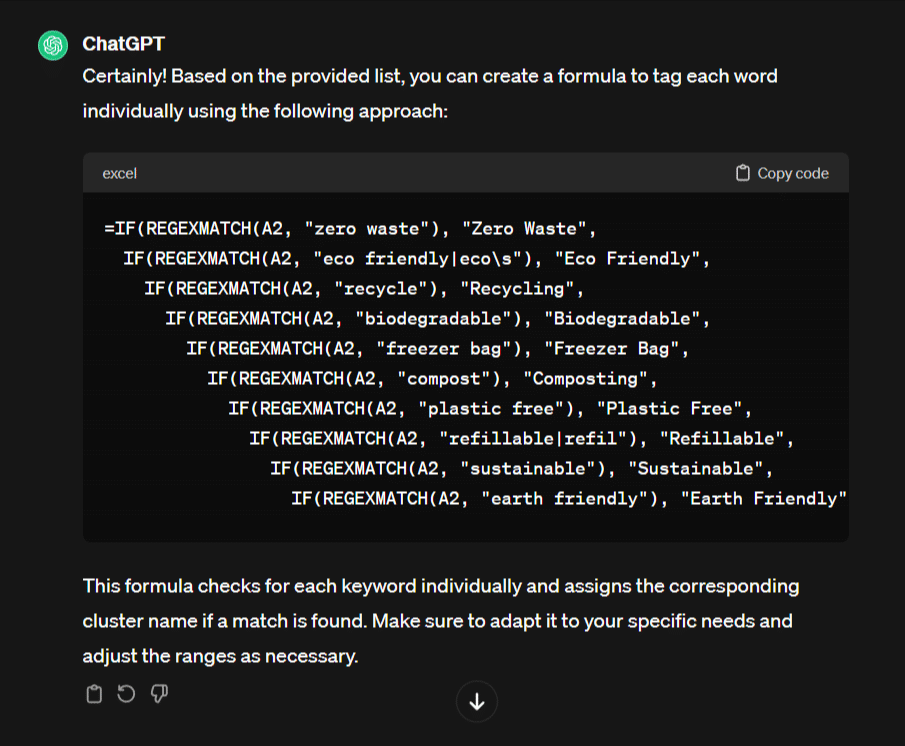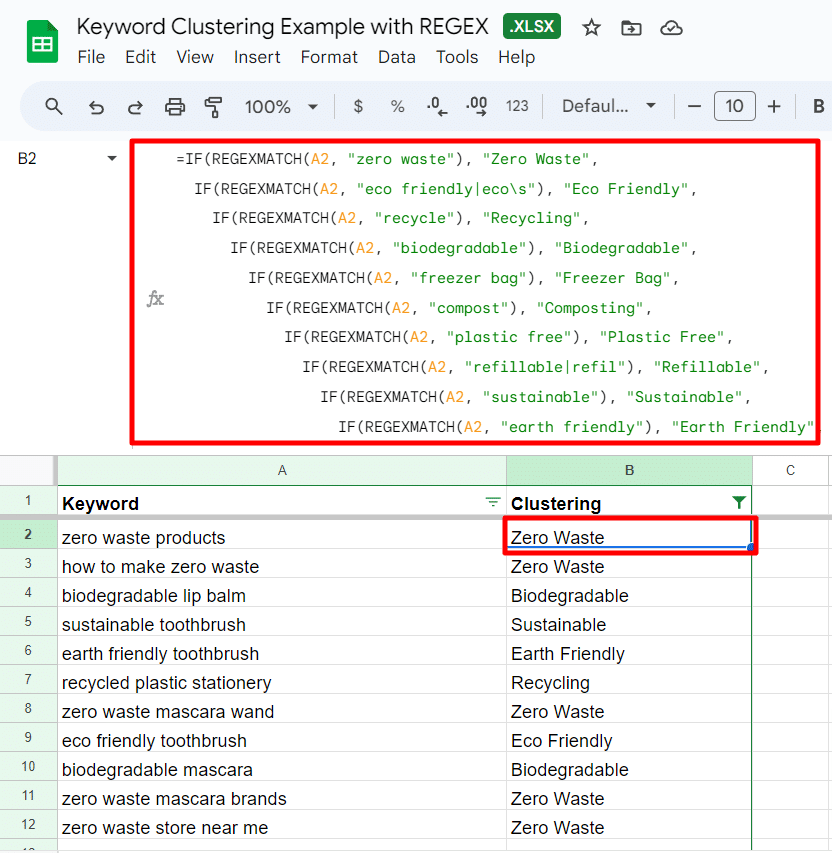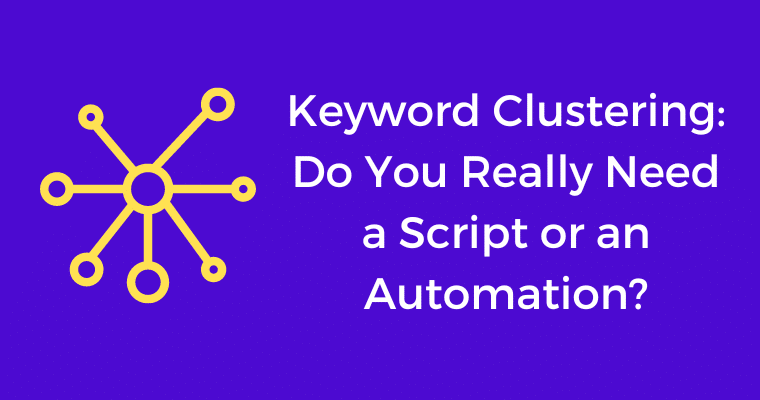Keyword Clustering is one of the most spoken topics in the industry especially when you work with Enterprise Brands or SaaS Brands that have to focus on content for different funnels heavily.
It is a good idea to cluster the keywords so that your keyword research has a meaning & context to it. Obviously, you have conducted keyword research so that you can use the same keyword research to action it in terms of building a landing page launch plan or deciding what kind of landing page you would like to launch based on the clustering.
Keyword Clustering on a broader level can mean two things here.
- Clustering Keywords Based on Intent
- Clustering Keywords based on similar buckets
1. Clustering Based on intent broadly means whether the keywords target Information, Commercial, Transactional or Navigational intent. This is very much in line with the state of SERP & helps you plan your page launch better.
For example, the keyword, men’s shoes clearly indicates that this is a commercial + informational intent page
However, once you append best to the beginning of it, it immediately becomes an informational intent keyword i.e. best shoes for men.
I mean sure this page could lead up to transactions nevertheless, you will have to create a listicle review article.
Clustering based on intent can largely be automated Semrush keyword research by default provides the intent classification & its largely accurate depiction. This is an area where Semrush’s automation can clearly be leveraged not to say that there aren’t any other tools. Here you can also leverage GPT for classification or certain Google Sheets add-ons.
2. Clustering keywords based on Similar Buckets
This is a bucket where a large part of discussions are engaged requiring a tool or an automation. Ideally, you would want to see clustering or grouping of similar keywords so that you can deal with one cluster at a time.
For example, if you have a fresh site that has never launched its blog you did exhaustive keyword research and found similar keywords like
- Causes for hairfall
- Hairfall reasons in female
- How to stop hairfall immediately
- Reason for hairfall in men
Now you know that all the above 4 keywords belong to hairfall cluster but your exhaustive keyword research wouldn’t only contain just 4 keywords it will contain way more than that.
This is where a lot of folks build either Python Scripts that leverage TF-IDF Vectorizer with Cosine Similarity or Sckit Learn kind of libraries based on which similar keywords are bucketed.
However, to a large degree based on my experience scripts and automation are perhaps not required. Sometimes it is the simpler solutions that come to save the day.
Based on the use case that I have encountered so far, for me Google Sheets IF(REGEXMATCH) condition has been more than enough to be totally honest.
However, I am open to exploring scripts or automation but more on that later. As of now let’s take a deep dive into how you can utilize regex for clustering.
Leverage IF(REGEXMATCH) + ChatGPT to Build Your Formula At Less Amount of Time
1. Scan your List of Keyword Research & Get a high-level idea of common Clusters
Now here I am not suggesting that you do clustering manually because that defeats the purpose of this blog.
But in essence, where you are doing exhaustive keyword research in general you do know what kind of clusters you are conducting keyword research for.
There are a handful of ways keyword research is conducted.
1. Download 1:1 Competitor Ranking Keywords because that would suit your website as well
2. Conduct Keyword Research cluster by cluster. Both Semrush & Ahrefs have the option of cluster-to-cluster keyword research here while conducting keyword research you are already aware of the cluster.
3. Cluster + Intent based keyword research. Let’s assume the use case is conducting keyword research for e-commerce where you want to download keywords that have commercial intent but not informational intent.
4. You leveraged CONCAT or CONCATENATE to form keyword permutations & now your keyword research tool would prove whether those keywords have volume or not here again in this step you can get the intent information.
The above 4 points were just to set the context of how keyword research is conducted generally.
Now as you already have a list of cluster keyword names you can leverage ChatGPT to build you IF(REGEXMATCH) formula that will help you cluster keywords at scale.
P.S. If you are new to regex then you like to read this regex guide.
2. Build the IF(REGEXMATCH) Formula by taking the help of ChatGPT
use this prompt & mention your list of keywords with their cluster name that you have in your mind

Earlier for clustering I used to build this formula manually but now with the help of ChatGPT, I can build this formula at a much faster pace.
As you can see in the screenshot above how ChatGPT within seconds built the formula which will now tag the keyword list with cluster name.

Using the IF(REGEXMATCH) formula from ChatGPT I was able to cluster more than 200 keywords within seconds.
I didn’t need a script or an automation paid tool for this & here I have controlled the accuracy too because I laid the foundation for the clustering.
What can we conclude?
To carry out keyword clustering in a controlled environment where are already aware of keyword clusters on a high level you probably don’t need a Python Script or an automation paid tool.
To a great degree, you can finish clustering the keyword list using the IF(REGEXMATCH) process.
However, a Python Script can be a lifesaver when you are dealing with a huge list of keywords that’s all over the place.
For carrying out clustering in a controlled environment you probably don’t need a paid tool that’s how I would like to conclude. I have been using this solution for more than a year now and have managed to finish clustering for keyword lists that had thousands of keywords in it.

Kunjal Chawhan founder of Decode Digital Market, a Digital Marketer by profession, and a Digital Marketing Niche Blogger by passion, here to share my knowledge

